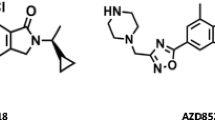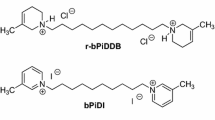Abstract
Rationale
Accumulated data suggest that N-methyl-d-aspartate (NMDA) receptors are involved in the reinforcing properties of nicotine. However, less is known about the role of α-amino-3-hydroxy-5-methyl-4-isoxazoleproprionate (AMPA) receptors in this context.
Objectives
To study the effect of the novel systemically administered AMPA receptor antagonist ZK200775 ([1,2,3,4-tetrahydro-7-morpholinyl-2,3-dioxo-6-(fluoromethyl) quinoxalin-1-yl] methylphosphonate) on nicotine-induced dopamine (DA) release in the nucleus accumbens (NAcc) and nicotine-stimulated locomotor activity (LMA) and particularly the relative role of NMDA and AMPA receptors in nicotine-stimulated DA release and LMA.
Methods
Male Wistar rats were administered ZK200775, CGP39551 or NBQX 30 min prior to nicotine and DA release and LMA was measured using in vivo microdialysis or photocell equipped activity boxes. Glutamate-produced neurotoxicity in cultured brain cells and binding assays were performed to determine the glutamate receptor subtype selectivity and affinity to nicotine receptors of ZK200775, respectively.
Results
ZK200775 (3.0 but not 1.5 or 6.0 mg/kg) significantly decreased the nicotine-induced (0.6 mg/kg) DA release in the NAcc and nicotine-stimulated LMA. ZK200775 (1.5, 3.0, 6.0 mg/kg) alone influenced neither DA release nor LMA. ZK200775 showed 34-fold selectivity for AMPA receptors compared to NMDA receptors and no affinity to nicotine receptors. The NMDA receptor antagonist CGP39551 (10 mg/kg) significantly decreased both the nicotine-induced DA release and nicotine-stimulated LMA whereas the AMPA receptor antagonist NBQX (10 mg/kg) had no effect. Notably, CGP39551 and ZK200775 (3.0 mg/kg) displayed a different pattern in inhibition of nicotine-induced DA release.
Conclusions
Both NMDA- and AMPA receptors are involved in nicotine’s dependence-producing properties, although in a spatiotemporally differential manner.










Similar content being viewed by others
References
Benwell MW, Balfour DJ (1992) The effects of acute and repeated nicotine treatment on nucleus accumbens dopamine and locomotor activity. Br J Pharmacol 105:849–856
Benwell MW, Balfour DJ, Birrel CE (1993) The influence of tetrodotoxin and calcium on the stimulation of mesolimbic dopamine activity evoked by systemic nicotine. Psychopharmacology 112:467–471
Breese CR, Logel J, Adams C, Leonard SS (1996) Regional gene expression of the glutamate receptor subtypes GluR1, GluR2, and GluR3 in human postmortem brain. J Mol Neurosci 7:277–289
Cebere A, Liljequist S (2003) Ethanol differentially inhibits homoquinolinic acid- and NMDA-induced neurotoxicity in primary cultures of cerebellar granule cells. Neurochem Res 28:1193–1199
Cebers G, Cebere A, Zharkovsky A, Liljequist S (1996) Glycine does not reverse the inhibitory actions of ethanol on NMDA receptor functions in cerebellar granule cells. Naunyn Schmiedeberg’s Arch Pharmacol 354:736–745
Cebers G, Zhivotovsky B, Ankarcrona M, Liljequist S (1997) AMPA neurotoxicity in cultured cerebellar granule neurons: mode of cell death. Brain Res Bull 43:393–403
Cebers G, Cebere A, Liljequist S (1998) Metabolic inhibition potentiates AMPA-induced Ca2+ fluxes and neurotoxicity in rat cerebellar granule cells. Brain Res 779:194–204
Corrigall WA, Franklin KB, Coen KM, Clarke PB (1992) The mesolimbic dopaminergic system is implicated in the reinforcing effects of nicotine. Psychopharmacology 107:285–289
Dev KK, Petersen V, Honore T, Henley JM (1996) Pharmacology and regional distribution of the binding of 6-[3H]nitro-7-sulphamoylbenzo[f]-quinoxaline-2,3-dione to rat brain. J Neurochem 67:2609–2612
Di Chiara G, Imperato A (1986) Preferential stimulation of dopamine release in the nucleus accumbens by opiates, alcohol, and barbiturates: studies with transcerebral dialysis in freely moving rats. Ann N Y Acad Sci 473:367–381
Ferrari R, Le Nowere N, Picciotto MR, Changeux JP, Zoli M (2002) Acute and long-term changes in the mesolimbic dopamine pathway after systemic or local single nicotine injections. Eur J Neurosci 15:1810–1818
Fu Y, Matta SG, Gao W, Brower VG, Sharp BM (2000) Systemic nicotine stimulates dopamine release in nucleus accumbens: re-evaluation of the role of N-methyl-d-aspartate receptors in the ventral tegmental area. J Pharmacol Exp Ther 294:458–465
Grillner P, Svensson TH (2000) Nicotine-induced excitation of midbrain dopamine neurons in vitro involves ionotropic glutamate receptor activation. Synapse 38:1–9
Harris KM, Miller RJ (1989) CNQX (6-cyano-7-nitroquinoxaline-2,3-dione) antagonizes NMDA-evoked [3H]GABA release from cultured cortical neurons via an inhibitory action at the strychnine-insensitive glycine site. Brain Res 489: 85–89
Hernandez L, Lee F, Hoebel BG (1987) Simultaneous microdialysis and amphetamine infusion in the nucleus accumbens and striatum of freely moving rats: increase in extracellular dopamine and serotonin. Brain Res Bull 19 23–28
Houghtling RA, Davila-Garcia MI, Kellar KJ (1995) Characterization of (±)(-)[3H]epibatidine binding to nicotinic cholinergic receptors in rat and human brain. Mol Pharmacol 48:280–287
Hyytia P, Backstrom P, Liljequist S (1999) Site-specific NMDA receptor antagonists produce differential effects on cocaine self-administration in rats. Eur J Pharmacol 378:9–16
Imperato A, Di Chiara G (1986) Preferential stimulation of dopamine release in the nucleus accumbens of freely moving rats by ethanol. J Pharmacol Exp Ther 239:219–228
Imperato A, Mulas A, Di Chiara G (1986) Nicotine preferentially stimulates dopamine release in the limbic system of freely moving rats. Eur J Pharmacol 132:337–338
Jackson A, Mead AN, Stephens DN (2000) Behavioural effects of alpha-amino-3-hydroxy-5-methyl-4-isoxazolepropionate-receptor antagonists and their relevance to substance abuse. Pharmacol Ther 88:59–76
Karcz-Kubicha M, Liljequist S (1995) Evidence for an anxiogenic action of AMPA receptor antagonists in the plus-maze test. Eur J Pharmacol 279:171–177
Kessler M, Baudry M, Lynch G (1989) Quinoxaline derivatives are high-affinity antagonists of the NMDA receptor-associated glycine sites. Brain Res 489: 377–382
Kessler M, Mutneja MS, Rogers G, Lynch G (1998) Regional preferences of AMPA receptor modulators determined through agonist binding autoradiography. Brain Res 783: 121–126
Koob GF, Bloom FE (1988) Cellular and molecular mechanisms of drug dependence. Science 242:715–723
Kuhar MJ, Ritz MC, Boja JW (1991) The dopamine hypothesis of the reinforcing properties of cocaine. Trends Neurosci 14:299–302
Lester RA, Quarum ML, Parker JD, Weber E, Jahr CE (1989) Interaction of 6-cyano-7-nitroquinoxaline-2,3-dione with the N-methyl-d-aspartate receptor-associated glycine binding site. Mol Pharmacol 35:565–570
Liu Y, Peterson DA, Kimura H, Schubert D (1997) Mechanism of cellular 3-(4,5-dimethylthiazol-2-yl)-2,5-diphenyltetrazolium bromide (MTT) reduction. J Neurochem 69:581–593
Liljequist S, Cebers G, Kalda A (1995) Effects of decahydroisoquinoline-3-carboxylic acid monohydrate, a novel AMPA receptor antagonist, on glutamate-induced Ca2+ responses and neurotoxicity in rat cortical and cerebellar granule neurons. Biochem Pharmacol 50:1761–1774
Loftis JM, Janowsky A (2003) The N-methyl-d-aspartate receptor subunit NR2B: localization, functional properties, regulation, and clinical implications. Pharmacol Ther 97:55–85
Marcus MM, Mathe JM, Nomikos GG, Svensson TH (2001) Effects of competitive and non-competitive NMDA receptor antagonists on dopamine output in the shell and core subdivisions of the nucleus accumbens. Neuropharmacology 40:482–490
Mares P, Mikulecka A, Pometlova M (1997) Anticonvulsant action of 2,3-dihydroxy-6-nitro-7-sulfamoyl-benzo(f)quinoxaline in immature rats: comparison with the effects on motor performance. J Pharmacol Exp Ther 281:1120–1126
Martin LJ, Blackstone CD, Levey AI, Huganir RL, Price DL (1993) AMPA glutamate receptor subunits are differentially distributed in rat brain. Neuroscience 53:327–358
McGehee DA, Role LW (1995) Physiological diversity of nicotinic acetylcholine receptors expressed by vertebrate neurons. Annu Rev Physiol 57:521–546
Mead AN, Stephens DN (1999) CNQX but not NBQX prevents expression of amphetamine-induced place preference conditioning: a role for the glycine site of the NMDA receptor, but not AMPA receptors. J Pharmacol Exp Ther 290:9–15
Menniti F, Chenard B, Collins M, Ducat M, Shalaby I, White F (1997) CP-101,606, a potent neuroprotectant selective for forebrain neurons. Eur J Pharmacol 331:117–126
Mifsud JD, Hernandez L, and Hoeberl BG (1989) Nicotine infused into the nucleus accumbens increases synaptic dopamine as measured by in vivo microdialysis. Brain Res 478:365–367
Monaghan DT, Yao D, Cotman CW (1984) Distribution of [3H]AMPA binding sites in rat brain as determined by quantitative autoradiography. Brain Res 324:160–164
Mossman T (1983) Rapid colorimetric assay for cellular growth and survival: application to proliferation and cytotoxicity assays. J Immunol Meth 65:55–63
Nielsen EO, Drejer J, Cha JH, Young AB, Honore T (1990) Autoradiographic characterization and localization of quisqualate binding sites in rat brain using the antagonist [3H]6-cyano-7-nitroquinoxaline-2,3-dione: comparison with (R,S)-[3H]alpha-amino-3-hydroxy-5-methyl-4-isoxazolepropionic acid binding sites. J Neurochem 54:686–695
Nisell M, Nomikos GG and Svensson TH (1994) Infusion of nicotine in the ventral tegmental area or the nucleus accumbens of rat differentially affects accumbal dopamine release. Pharmacol Toxicol 75:348–352
Paxinos G, Watson C (1986) The rat brain in stereotaxic coordinates, 4th edn. Academic Press, New York
Picciotto MR (1998) Common aspects of the action of nicotine and other drugs of abuse. Drug Alcohol Depend 51:165–172
Pellegrini-Giampietro DE, Galli A, Alesiani M, Cherici G, Moroni F (1989) Quinoxalines interact with the glycine recognition site of NMDA receptors: studies in guinea-pig myenteric plexus and in rat cortical membranes. Br J Pharmacol 98:1281–1286
Porter RH, Greenamyre JT (1994) Regional variations in the pharmacology of AMPA receptors as revealed by receptor autoradiography. Brain Res 664:202–206
Reid MS, Fox L, Ho LB, Berger SP (2000) Nicotine stimulation of extracellular glutamate levels in the nucleus accumbens: neuropharmacological characterization. Synapse 35:129–136
Romano C, Goldstein A (1980) Stereospecific nicotine receptors on rat brain membranes. Science 210:647–650
Sakai K, Akiyama K, Kashihara K, Tsuchida K, Ujike H, Kuroda S, Shohmori T (1997) AMPA receptors modulate dopamine release in the striatum, as measured by brain microdialysis. Neurochem Int 30:329–336
Schilstrom B, Nomikos GG, Nisell M, Hertel P, Svensson TH (1998) N-Methyl-d-aspartate receptor antagonism in the ventral tegmental area diminishes the systemic nicotine-induced dopamine release in the nucleus accumbens. Neuroscience 82:781–789
Schoepp DD, Lodge D, Bleakman D, Leander JD, Tizzano JP, Wright RA, Palmer AJ, Salhoff CR, Ornstein PL (1995) In vitro and in vivo antagonism of AMPA receptor activation by (3S, 4aR, 6R, 8aR)-6-[2-(1(2)H-tetrazole-5-yl) ethyl] decahydroisoquinoline-3-carboxylic acid. Neuropharmacology 34:1159–1168
Sheardown MJ, Nielsen EO, Hansen AJ, Jacobsen P, Honore T (1990) 2,3-Dihydroxy-6-nitro-7-sulfamoyl-benzo(F)quinoxaline: a neuroprotectant for cerebral ischemia. Science 247:571–574
Stephens DN, Brown G (1999) Disruption of operant oral self-administration of ethanol, sucrose, and saccharin by the AMPA/kainate antagonist, NBQX, but not the AMPA antagonist, GYKI 52466. Alcohol Clin Exp Res 23:1914–1920
Sziraki I, Sershen H, Hashim A, Lajtha A (2002) Receptors in the ventral tegmental area mediating nicotine-induced dopamine release in the nucleus accumbens. Neurochem Res 27:253–261
Toth E, Vizi ES, Lajtha A (1993) Effect of nicotine on levels of extracellular amino acids in regions of the rat brain in vivo. Neuropharmacology 32:827–832
Turski L, Jaconsen P, Honoré T, Stephens DN (1992) Relief of experimental plasticity and anxiolytic/anticonvulscant actions of the alpha-amino-3-hydroxy-5-methyl-4-isoxazole propionate antagonist, 2,3-dihydro-6-nitro-7-sulfamoyl-benzo(F)quinoxaline. J Pharmacol Exp Ther 260:742–747
Turski L, Huth A, Sheardown M, McDonald F, Neuhaus R, Schneider HH, Dirnagl U, Wiegand F, Jacobsen P, Ottow E (1998) ZK200775: a phosphonate quinoxalinedione AMPA antagonist for neuroprotection in stroke and trauma. Proc Natl Acad Sci USA 95:10960–10965
Turski L, Schneider HH, Neuhaus R, McDonald F, Jones GH, Lofberg B, Schweinfurth H, Huth A, Kruger M, Ottow E (2000) Phosphonate quinoxalinedione AMPA antagonists. Restor Neurol Neurosci 17:45–59
Vanover KE (1998) Effects of AMPA receptor antagonists on dopamine-mediated behaviors in mice. Psychopharmacology 136:123–131
Wang T, French ED (1993) Electrophysiological evidence for the existence of NMDA and non-NMDA receptors on rat ventral tegmental dopamine neurons. Synapse 13:270–277
Williams K (2001) Ifenprodil, a novel NMDA receptor antagonist: site and mechanism of action. Curr Drug Targets 2:285–298
Wise RA, Bozarth MA (1987). A psychomotor stimulant theory of addiction. Psychol Rev 94:469–492
Acknowledgements
This study was supported by the Swedish Medical Research Council (project no. 7688), Sigurd and Elsa Golje’s Minne Foundation for Medical Research, Swedish Match Foundation for Nicotine Research, and funds from the Karolinska Institutet.
Author information
Authors and Affiliations
Corresponding author
Rights and permissions
About this article
Cite this article
Kosowski, A.R., Cebers, G., Cebere, A. et al. Nicotine-induced dopamine release in the nucleus accumbens is inhibited by the novel AMPA antagonist ZK200775 and the NMDA antagonist CGP39551. Psychopharmacology 175, 114–123 (2004). https://doi.org/10.1007/s00213-004-1797-7
Received:
Accepted:
Published:
Issue Date:
DOI: https://doi.org/10.1007/s00213-004-1797-7




